Mexico
United Mexican States Estados Unidos Mexicanos


Pronunciation: MEH-hee-koh.
Origin of state name: The country name comes from words in the language of the indigenous Náhuatl people: metztli (moon), xictli (center), and co (place).
Capital: Mexico City
Coat of Arms: The national coat of arms is an eagle with a snake in its beak, perched on a cactus.
Holidays: Año Nuevo (New Year's Day—January 1); Día de la Constitución (Constitution Day—February 5); Benito Juárez's birthday (March 21); Primero de Mayo (Labor Day—May 1); Revolution Day, 1910 (November 20); and Navidad (Christmas—December 25).
Flag: The national flag is a tricolor of green, white, and red vertical stripes; at the center of the white stripe is the national coat of arms.
Time: 6 AM = noon Greenwich Mean Time (GMT).
1 Location and Size
Situated south of the United States on the North American continent, Mexico has an area of 1,972,550 square kilometers (761,606 square miles), including many uninhabited islands off the east and west coasts, which have a combined area of 5,073 square kilometers (1,959 square miles). Mexico is slightly less than three times the size of the US state of Texas, including the narrow peninsula of Baja. Mexico has a total boundary length of 13,683 kilometers (8,501 miles). The capital city, Mexico City, is located in the south-central part of the country.
Mexico's dominant geographic feature is the great highland central plateau, which occupies most of the width of the country, extending from the US border to the Isthmus of Tehuantepec (an isthmus is a narrow strip of land that connects two larger areas, in this case the Bay of Campeche on the north and the Gulf of Tehuantepec on the south) . The plateau is enclosed by two high cordilleras (mountain chains), the Sierra Madre Oriental on the east and the Sierra Madre Occidental on the west, each separated from the coast by lowland plains. The ranges rise to over 3,000 meters (10,000 feet), and some volcanic peaks exceed 5,000 meters (16,400 feet). Pico de Orizaba, or Citlaltépetl (5,700 meters/18,702 feet ), is the highest point in the country. The Laguna Salada is the lowest point of the country (10 meters/33 feet below sea level).
The Río Bravo del Norte (known as the Río Grande in the United States) is a river that extends for about 2,100 kilometers (1,300 miles) of the boundary with the United States. The Papaloapan River is an important source of waterpower. The largest lake in Mexico is Lake Chapala (in the state of Jalisco), which covers about 1,686 square kilometers (651 square miles).
2 Climate
The climate varies according to altitude and rainfall. The coastal plains, Yucatán Peninsula, and lower areas of southern Mexico have a mean temperature of 25° c to 27° c (77° f to 81° f ). The temperate zone (tierra templada) has a mean temperature of 21° c (70° f ). Mexico City and most other important population centers are in the cool zone (tierra fria), with a mean annual temperature of 17° c (63° f ). The highest mountain peaks are always covered with snow.
Annual rainfall may exceed 500 centimeters (200 inches) in the Isthmus of Tehuantepec, while in parts of Baja California there is practically no rainfall. Precipitation is adequate in central Mexico, while in the northern states desert-like conditions prevail.
3 Plants and Animals
Plant and animal life differs sharply with Mexico's varied climate and topography. The coastal plains are covered with a tropical rain forest, which merges into subtropical and temperate growth as the plateau rises. In the dry northern states, there are fewer trees and vegetation, with desert plants covering much of the area. Oaks and conifers are found in mixed forest regions along the mountain slopes. The Yucatán Peninsula has scrubby veg-etation.
Among the wild animals are the armadillo, tapir, jaguar, bear, and several species of monkey, deer, and boar. Poisonous snakes and harmful insects also are found. In the coastal marshes malarial mosquitoes pose a problem. The only remaining elephant seals in the world are on Guadalupe Island west of Baja California.
4 Environmental Protection
Mexico loses its forest at a rate of about 0.9% annually due to agricultural and industrial expansion. Mexico City has chronic smog, aggravated by the pres ence of thousands of factories, by more than two million motor vehicles, and by open burning of garbage by many citizens. Cities along the US-Mexican border also suffer from serious air pollution. Transportation vehicles are responsible for 76% of the air pollution. Water pollution results from the combined impact of industrial, agricultural, and public waste. In the north, fresh water resources are scarce and polluted. In the central-southeast region, water is frequently inaccessible and of poor quality.
Mexico has the fourth most extensive mangrove (a tropical evergreen) area in the world. In 2001, sixty-four of the nation's mammal species and thirty-six bird species were endangered, including the Mexican grizzly bear (possibly extinct), the southern bald eagle, the ridge-nosed rattlesnake, and two species of crocodile. At least thirty
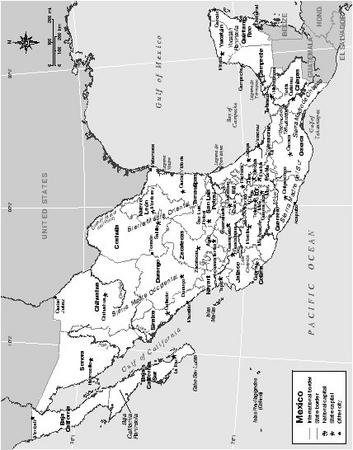
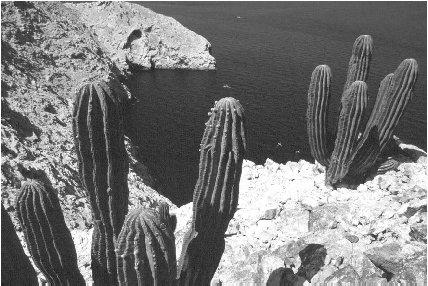
Cactii growing on San Pedro Martin Island.
5 Population, Ethnic Groups, Languages
In 2003, the population of Mexico was estimated by the United Nations at 103.4 million. It is projected to total 119.6 million by 2015. In 2002, the population density averaged 52 persons per square kilometer (135 persons per square mile). In 2003, approximately 33% of the population was under fifteen years of age. About 74% of the population lived in urban areas in 2001.
In 1990, the US Census Bureau estimated that 13.5 million persons of Mexican ancestry were living in the United States. Likewise, the largest community of US citizens living outside the United States is found in Mexico.
The people of Mexico are mostly Mestizos, a mixture of native Amerindian and Spanish heritage. There are small numbers of persons of other European heritage. At last estimates, 60% of the population was Mestizo, 30% was pure Amerindian, 9% was white, and 1% was something other. Amerindian influence on Mexican cultural, economic, and political life is very strong.
Spanish is the official language and is spoken by nearly the entire population. This gives Mexico the world's largest Spanish-speaking community, since more Mexicans speak Spanish than do Spaniards. Only a small number of inhabitants, about 1% of the population according to the last estimate, speak only indigenous Amerindian languages or dialects. A larger percentage, some 7.5% at last estimate, speak an Amerindian language as well as Spanish. There are at least thirty-one different Amerindian language groups, the principal languages being Nahuatl, Maya, Zapotec, Otomi, and Mixtec.
6 Religions
According to the 2000 census, about 88% of the Mexican population is affiliated with the Roman Catholic Church and about 6% is Protestant. There are small Greek and Russian Orthodox communities. There are also small numbers of Seventh-Day Adventists, Jehovah's Witnesses, Mormons, Jews, Buddhists, and Muslims. While professing the Roman Catholic faith, a number of indigenous people include strong pre-Hispanic Mayan elements in their religion.
Veneration of the patron saints plays an important role in Mexican life, and the calendar is full of feast days (fiestas). These predominantly Roman Catholic celebrations include many ancient Amerindian rites and customs and, invariably, bands of mariachi musicians playing Mexican folk songs.
7 Transportation
In 2002, the country had about 323,977 kilometers (201,319 miles) of roads and 18,000 kilometers (11,185 miles) of railroads. In 2000, there were over 8.7 million registered vehicles, including 5.5 million passenger cars and 3.2 million commercial vehicles. Mexico has 2,900 kilometers (1,802 miles) of inland waterways and lakes, but these are not as important to transportation as are ocean and coastal shipping areas. There are 102 ocean ports, the most important being Tampico and Veracruz, on the Gulf of Mexico; Mazatlán and Manzanillo on the Pacific coast; and Guayamas on the Gulf of California.
In 2001, there were an estimated 1,852 airports and airfields. Principal airports include Juan N. Alvarez at Acapulco, Cancún International at Cancún, and Benito Juárez at Mexico City. Mexican commercial aircraft carried twenty million passengers on scheduled domestic and international flights in 2001. The main airline company is Aeroméxico.
8 History
The land now known as Mexico was inhabited by many of the most advanced Amerindian cultures of the ancient Americas. The Mayan civilization in the Yucatán Peninsula began about 2500 B . C ., flourished about 300 to 900 A . D ., and then declined until its conquest by the Spanish.
The Mayas were skillful in the construction of stone buildings and the carving of stone monuments. They built great cities at Chichen-Itzá and many other sites. In the early 10th century the Toltecs founded their capital of Tollan (now Tula), and made the Nahua culture, of which they were a part, predominant in the Valley of Mexico until the early 13th century. At that time, the Aztecs, another Nahua tribe, gained control.
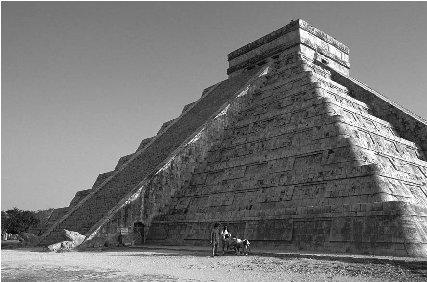
The Kukulcán Pyramid at Chichén Itzá was planned so that the setting sun would cast a shadow of a serpent writhing down the steps of the pyramid during the vernal equinox (longest day of the year).
The Aztecs were skilled in architecture, engineering, mathematics, weaving, and metalworking. They had a powerful priesthood and a complex religion dominated by the sun god and war god Huitzilopochtli, to whom prisoners captured from other tribes were sacrificed.
The empire was at its height in 1519, when the Spanish, under Hernán Cortés (1485–1547), landed at present-day Veracruz. With superior weapons and the cooperation of local chieftains, the Spaniards conquered Mexico by 1521. First, Cortés imprisoned the Aztec emperor Montezuma II (1466–1520). Then Montezuma's nephew, Cuauhtémoc (or Guatimotzin, c. 1495–1522), drove the Spanish from Tenochtitlán (ancient name of Mexico City) on June 30, 1520. This is now called "la noche triste" ("the sad night"), during which Montezuma died, probably at the hands of the Spaniards. Cortés later returned to Tenochtitlán and defeated Cuauhtémoc.
The Spaniards brought Roman Catholicism to Mexico, imposed their legal and economic system on the country, and enslaved many of the inhabitants. The combination of Spanish oppression and the diseases the conquistadors (Spanish conquerors) brought with them reduced the Amerindian population from an estimated 5 million in 1500 to 3.5 million a century later.
Spain ruled Mexico as the viceroyalty of New Spain for three centuries. Continued political abuses and Amerindian enslavement, combined with the political uncertainty that followed French emperor Napoleon's (1769–1821) invasion of Spain in 1807, produced a Mexican independence movement. Between 1810 and 1815, several unsuccessful revolts took place. In 1821, independence was finally proclaimed and secured. Agustín de Iturbide (1783–1824) proclaimed himself emperor of Mexico in 1822 but was deposed in 1823, when a republic was established.
Over the next twenty-five years, there were at least thirty changes of government. General Antonio López de Santa Anna (1794–1876) became the dominant figure in the 1830s and 1840s to attempt to centralize the new government. Texas gained its independence from Mexico in 1836 as a result of the defeat of Santa Anna at San Jacinto. It joined the United States in 1845 after a brief period as a republic. Mexico lost the subsequent war with the United States (1846–48), which began over a dispute about the border of Texas. Under the Treaty of Guadalupe Hidalgo, Mexico recognized the Rio Grande as the boundary of Texas and ceded half its territory (much of the present western United States) in return for $45 million.
A reform government was established in 1855 after a revolt against Santa Anna, and a new liberal constitution was adopted in 1857. In 1861, French troops under Emperor Napoleon III (1808–1873) intervened in Mexico, supposedly because Mexico had not paid its debts. They installed Archduke Maximilian of Austria (1832–1867) as emperor. The French withdrew in 1866. Maximilian was executed and the republic was restored in 1867.
Porfirio Díaz (1830–1915) seized power in 1867 and assumed the presidency. He held this position almost continuously until 1911. Under his dictatorship, Mexico modernized by opening its doors to foreign investors and managers. At the same time, all dissent was suppressed, and there was a complete lack of concern with improving the lives of Mexican peasants. An elite corps of mounted police, the Rurales, held the rural areas in check. Resentment among the middle classes and the peasantry continued to grow.
After Díaz was once again reelected to the presidency in 1910, the Mexican Revolution erupted. This revolution had claimed perhaps one million lives by 1917. It was, on the one hand, a protest by middle-class political liberals against the oppressive Díaz regime and, on the other hand, a massive popular rebellion of peasants who demanded the right to own land. The interests of these two groups sometimes coincided but more often clashed. Riots in Mexico City forced Díaz to resign and leave the country in 1911. Liberal politician Francisco Indalecio Madero (1873–1913) was elected president that year. Meanwhile, popular revolts led by Emiliano Zapata (1879–1919) and Francisco "Pancho" Villa (1878–1923), who refused to submit to Madero's authority, led the country into chaos. Madero was ousted and murdered in 1913 by General Victoriano Huerta (1854–1916).
When Huerta, a corrupt dictator, was driven from power in July 1914, a full-scale civil war broke out. This phase of the revolution ended in February 1917 when a new constitution was proclaimed. This document was considered by some to be the world's
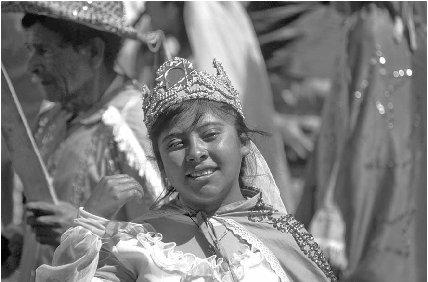
A young girl celebrates during a festival honoring the Michoacan's ancient Purépecha empire and the indigenous Purépacha people.
Venustiano Carranza (1859–1920) was elected president in 1917, but for the next decade Mexico was still beset by political instability and fighting between various revolutionary groups. Most of the revolutionary leaders met with violent deaths. Zapata, still regarded by many as a revolutionary hero, was assassinated in 1920.
Political stability at last came to Mexico with the formation in 1929 of an official government party that incorporated most of the social groups that had participated in the revolution. It has been known since 1945 as the Institutional Revolutionary Party (Partido Revolucionario Institucional—PRI). Although founded to support the interests of peasants, workers, and other disadvantaged groups, it has also been closely allied with business since the 1940s. Considered to be one of the most outstanding political leaders of the post-1929 era, Lázaro Cárdenas (1895–1970), who was president from 1934 to 1940, sought with some success to realize the social goals of the revolution. His reforms included massive land redistribution, establishment of strong labor unions, extension of education to remote areas of the country, and in 1938, the takeover of foreign petroleum holdings, mostly US-owned.
The years since World War II (1939–45) have been marked by political stability, economic expansion, and the rise of the middle class, but also by general neglect of the poorest segments of the population. An economic boom during the late 1970s, brought about by huge oil export earnings, benefited a small percentage of the people. Still, millions of peasants continued to be only slightly better off than in 1910. Declining world oil prices in 1981 led to a severe financial crisis in 1982. Mexico's new president, Miguel de la Madrid Hurtado, put economic austerity measures into place. He also promised a crackdown on corruption, which has long been a problem in Mexico. In October 1987, the PRI named Carlos Salinas de Gortari as its candidate to succeed President de la Madrid in December 1988. Salinas' legitimacy was questioned as there was a complete shutdown of the computer systems that were calculating the votes that brought him into office. Salinas promoted the privatization of state industries and free trade agreements. In September 1993, changes in federal electoral were designed to make elections free from corruption.
Mexico City was devastated by a major earthquake in September 1985. The official death toll was seven thousand, although unofficial estimates were as high as twenty thousand. In addition, 300,000 were left homeless. There was widespread protest over the fact that many of the buildings destroyed had been built in violation of construction regulations and claims that foreign emergency aid had been mishandled by the government.
In August 1992, formal negotiations regarding the North American Free Trade Agreement (NAFTA) were concluded, whereby Mexico would join the United States and Canada in the elimination of trade barriers, the promotion of fair competition, and increased investment opportunities. NAFTA went into effect on January 1, 1994.
In January 1994, a primarily Amerindian group calling itself the Zapatista Army of National Liberation resorted to an armed uprising against the government. The group initially took control of four municipalities in Chiapas to protest what it regarded as government failure to effectively deal with regional social and economic problems. Two months after the Zapatista uprising, the nation witnessed its first high-level political assassination in over sixty years when PRI presidential candidate Luis Donaldo Colosio was murdered in Tijuana, in Baja California. His replacement, Ernesto Zedillo, was elected at the end of the year in a closely monitored campaign.
In December 1994 the Mexican peso was devalued. The economy went into its worst recession in more than fifty years. Over a million Mexicans lost their jobs. The United States responded to its neighbor's distress with a multimillion-dollar bailout that kept the economy from getting worse.
The public discontent with the economic crisis, poverty, crime, corruption, and political instability, led in 1997 to a rejection of Mexico's nearly seventy-year-old system of one-party rule. In June of that year, the PRI lost its majority in the lower house of the National Congress to the combined power of the leftist Party of the Democratic Revolution (PRD) and the conservative National Action Party (PAN).
In December 2000, Vicente Fox Quesada of the conservative PAN Party became president, the first non-PRI ruler in more than seventy years. By mid-2003, Fox had lost popularity after his two most symbolic legislative initiatives failed to pass the divided congress. The president failed to solve the indigenous revolt in Chiapas. A tax reform aimed at increasing government revenues to beef up social spending was also significantly scaled back. President Fox's legislative and government agendas moved slowly and many Mexicans then looked to the PRI as a government alternative.
9 Government
Mexico is a federal republic consisting of thirty-one states and the Federal District (Mexico City). The president is elected for a six-year term by universal adult vote (beginning at age eighteen) and is not eligible for reelection. The president appoints the attorney general and a cabinet, which may vary in number. There is no vice president. If the president dies or is removed from office, the congress elects a provisional president.
The two-chamber Mexican Congress, also elected by direct universal suffrage, is composed of a Senate (Cámara de Senadores) made up of 128 members (four from each state and four from the Federal District) and a Chamber of Deputies (Cámara de Diputados) made up of 500 members. Senators are elected for six-year terms with half the Senate being elected every three years. Deputies are elected for three-year terms. Both groups are ineligible for immediate reelection.
In an effort to unite various interest groups within the government party, a National Consultative Committee, composed of living ex-presidents of Mexico, was formed in 1961 by President Adolfo López Mateos (1958–64).
Mexico's 2,378 municipalities are the principal units of state government. Each state has a constitution, a governor elected for six years, and a one-chamber legislature, with representatives elected by district vote in proportion to population.
10 Political Parties
From 1929 to 1997, the majority party and the only political group to gain national significance was the Institutional Revolutionary Party (Partido Revolucionario Institucional) or PRI. In the July 1997 elections, however, the PRI only retained 239 seats in the Chamber of Deputies, which was not enough to claim a majority. On July 2, 2000, Vicente Fox Quesada of the conservative National Action Party (PAN) was elected as president. That year, PAN also became the largest party in the Chamber of Deputies, with 223 seats. Also in 2000, the PRI won 60 out of 128 seats in the Senate. The Party of the Democratic Revolution (PRD) won 53 seats in the Chamber of Deputies and 17 in the Senate. Thus, no party had a majority within either chamber of the Mexican Congress.
The PRI includes only civilians and embraces all shades of political opinion. Three large pressure groups operate within the PRI: labor, the peasantry, and the "popular" sector (such as bureaucrats, teachers, and small business people). The PAN favors a reduced government role in the economy, backs close ties with the United States, and is closely linked to the Catholic Church. The PRD advocates active government intervention in economic matters and questions close relations with the United States.
11 Judicial System
Federal courts include the Supreme Court (with twenty-one magistrates), thirty-two circuit tribunals, and ninety-eight district courts, with one judge each.
The jury system is not commonly used in Mexico, but judicial protection is provided by the Writ of Amparo, which allows a person convicted in the court of a local judge to appeal to a federal judge. Low pay and high caseloads increase the possibility of corruption in the judicial system. Most lower court judges are selected by a competitive examination.
12 Economy
Although Mexico's economy once was mostly agricultural, commerce and industry have long been the nation's chief income earners. A great mining nation, Mexico is the world's leading producer of silver and has rich deposits of sulfur, copper, manganese, iron ore, lead, and zinc. Oil is also a leading product in Mexico. Oil accounted for 10% of the country's exports in 2002. Also in 2002, manufactured products accounted for 80% of exports.
Rapid population growth has been a burden on the economy. In 2001, an estimated 40% of the population was living below the poverty line. The economy showed improvement in the late 1990s; however, the recession and economic slowdown in the United States (beginning in 2001 and extending throughout the early part of the twenty-first century) affected Mexico's economy as well. In 2002, the economy only grew by 0.9%.
The North American Free Trade Agreement (NAFTA), in effect as of January 1, 1994, opened the domestic market to foreign trade by promising to eliminate trade barriers between Mexico, the United States, and Canada over the next twenty years. In 2001, free trade agreements were in place with the European Union (EU) and a number of Central American neighbors, as well, bringing over 90% of Mexico's trade under free trade agreements.
In 2001, Mexico's gross domestic product (GDP) was estimated at $920 billion, or about $9,000 per person. The average inflation rate in 2001 was 6.5%, and the growth rate in GDP was estimated at -0.3%.
13 Industry
Mexico is one of the leading manufacturing nations in Latin America. The principal manufacturing industries include food and beverages, tobacco, chemicals, iron and steel, petroleum, textiles, clothing, and motor vehicles. Other industries include footwear, metalworking, furniture, and other wood products. In 2001, Mexico produced 1.85 million motor vehicles. Leading manufacturers are Ford, Chrysler, General Motors, and Volkswagen.
Maquiladoras, which are facilities engaged in what is known as re-export processing, play an important role in Mexican manufacturing. Maquiladoras are usually located near the United States border and owned by foreign corporations. They assemble or process imported goods brought in from the United States and then re-export them duty-free. In 2002, there were some 3,200 maquiladora factories. However, due to recession and economic slowdowns, six hundred maquiladoras closed between 2001 and 2002, mostly in electronics and apparel. During that period, 250,000 jobs were lost, which amounted to 15% of the maquila workforce.
The fishing industry is largely handled by cooperative societies, which are
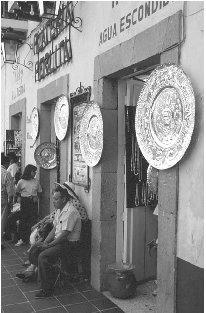
Silver shops on the Plaza Borda in Taxco.
14 Labor
The labor force in Mexico numbered 39.8 million in 2000. Services accounted for 56% of those employed, with industry accounting for 24%, and agriculture accounting for the remaining 20%. Underemployment is Mexico's major labor problem, affecting primarily those in agriculture. According to official figures, unemployment was 3% in 2001, but that figure reflected only the largest metropolitan areas. Rural unemployment was believed to be much higher. About 25% of the labor force was unionized in 2002.
The workday is generally eight hours. Double or triple pay must be paid for overtime. The minimum age for child employment is fourteen, but there are laws restricting the number of hours and the conditions under which children can work. These child labor laws are fairly well-enforced among medium and large companies but not in smaller firms or in agriculture. There is no national minimum wage, but some municipalities have minimum wage laws.
15 Agriculture
In 2001, agriculture contributed 4% to the gross domestic product and employed about 22% of the labor force. Only about 13% of Mexico's total land area is suitable for cultivation and only 6% is cultivated with permanent crops.
Mexico is self-sufficient in beans, rice, sugar, and most fruits and vegetables. In 1999, the principal crops included sugarcane (46 million tons), corn (18.3 million tons), sorghum (6.29 million tons), wheat (3 million tons), and barley (469,000 tons). Principal exports are coffee, cotton, fresh fruit, sugar, tobacco, and tomatoes. In 2001, the value of agricultural exports amounted to $7,631 million.
More than one-third of the total land area is suitable for pasture. In 2001, the livestock population was estimated at 30.6 million head of cattle, 16.5 million hogs, 9 million goats, 6.4 million sheep, 6.25 million horses (the third most in the world), 3.26 million donkeys, 3.27 million mules, and 498 million chickens. Output of livestock products in 2001 included 9.47 million tons of cows' milk, 140,000 tons of goats' milk, 1.44 million tons of beef and veal, 1.97 million tons of poultry meat, 1 million tons of pork, and 1.89 million tons of eggs.
16 Natural Resources
The waters of Mexico provide an abundant variety of fish. The main commercial catches are shrimp, sardines, bass, pike, abalone, Spanish mackerel, and red snapper. In 2000, the catch was 1,314,219 tons.
Mexico's forests are another important resource. About 55.2 million hectares (136.3 million acres) are classified as forest-land. Mexico has seventy-two species of pine, more than any other country, and pine accounts for over 80% of annual forestry production. Besides wood, annual forestry production also includes an estimated 100,000 tons of resins, fibers, oils, waxes, and gums. The indigenous peoples living in Mexico's rain forests use up to 1,500 species of tropical plants to manufacture three thousand different products such as medicines, construction and domestic materials, dyes, and poisons.
Mexico is one of the leading producers of silver, arsenic, graphite, salt, mine copper, gold, and crude steel. Silver output in 2000 was 2.62 million kilograms (5.7 million pounds). Copper output was 364,566 tons. In 2000, Mexico also produced mercury, tin, nitrogen, talc, and wollastonite.
17 Energy and Power
The total amount of electricity produced in 2000 was 193.9 billion kilowatt hours, of which 17% was hydroelectric and 4% was nuclear power. There are wide-ranging possibilities for geothermal electrical production, with more than one hundred thermal springs available for exploitation. Petroleum is used for more than half of Mexico's energy consumption.
Mexico's estimated oil reserves as of the beginning of 2002 were 26.9 billion barrels, second in the Western Hemisphere after Venezuela. The petroleum industry is operated by the government-owned company Mexican Petroleum (Petróleos Mexicanos—PEMEX). PEMEX is one of the world's largest oil companies, the largest civilian employer in Mexico, and the single most important business in the Mexican economy.
Crude oil production was about 3.6 million barrels per day during 2001. Mexico exports about half the oil it produces, mostly crude oil to the United States, Spain, and the Far East. Proven reserves of natural gas were estimated at 835 billion cubic meters (29.5 trillion cubic feet) in early 2002.
18 Health
In 1997, the National Social Security System operated 14,978 outpatient clinics and 372 general hospitals. In 1999 the country had around 152,000 nurses. As of 1999, there were an estimated 1.7 physicians per 1,000 people. In 2000, average life expectancy was estimated at 73 years for both men and women.
Cholera, yellow fever, plague, and smallpox have been virtually eliminated and typhus has been controlled. Permanent campaigns are being waged against malaria, poliomyelitis, skin diseases, tuberculosis, and serious childhood diseases. Major causes of death include communicable diseases, injuries, and circulatory diseases. As of 2001, the number of people living with HIV/AIDS was estimated at 150,000. Deaths from AIDS that year were estimated at 4,200.
19 Housing
Rapid population growth has led to housing shortages, particularly in rural areas and at the outskirts of major cities, such as Mexico City and Monterrey. The government has established several of its own housing programs and has received aid from international organizations such as the World Bank. In 2000, there were about 21,954,733 housing units; about 85% were detached homes. Most dwellings are privately owned; about 84% have running water and 78% have access to sewage services.
20 Education
Primary schooling is compulsory and free. Except in the Federal District, where education is administered by the federal government, schools are controlled by the states.
Since the 1990s virtually 100% of primary-school-age children have been enrolled in school. In 1999, 57% of secondary-school-age children attended school. Mexican classes have 25 to 28 pupils per teacher.
Major universities include the National Autonomous University (founded in 1551), the National Polytechnic Institute, and Iberoamericana University, all in Mexico City, and Guadalajara University, the Autonomous University of Guadalajara, and the Autonomous University of Nuevo León. In each state there are other state and private institutions.
The government provides extracurricular education through special centers for workers' training, art education, social work, and primary education. As of 2003, the adult illiteracy rate was estimated at 8% (males, 6%; females, 9%).
21 Arts
The National Foundation for the Arts and Culture of Mexico (Fondo Nacional para la Cultura y las Artes—FONCA) was established in 1989 to encourage and support both state and private arts institutions. The Fundación Cultural Omnilife was founded in 1996 to support and encourage Mexican artists and to promote the appreciation of Mexican art abroad. The National Advisory Committee for Culture and the Arts (Consejo Nacional para la Cultura y las Artes—CONACULTA) was established in 1988 as part of the Ministry of Education. Its mission is to work for the preservation of the Mexican cultural heritage and support art education in the country and abroad. There are several other arts associations throughout the country.
22 Libraries and Museums
The Mexican public library system has over 4,800 branches with about twenty million volumes. The National Library, which is affiliated with the National University of Mexico, has about three million volumes. Other important collections include the Library of Mexico, the Library of the Secretary of the Treasury, and the Central Library of the National Autonomous University in Mexico City.
The National Museum of Anthropology in Mexico City, founded in 1825, has over 600,000 exhibits and a library of 300,000 volumes. Among its exhibits are the famous Aztec calendar stone and a 137-ton figure of
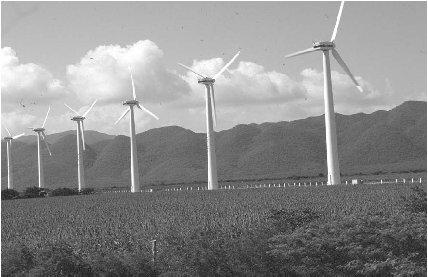
Seven wind turbines installed in Oaxaca in the narrow isthmus of Tehuantepec are the only wind-power generators in Mexico.
23 Media
The number of mainline telephones in service in 2000 was 12.3 million. In 1998, there were also two million cellular phones in use. As of 2000, there were 851 AM and 598 FM radio stations and 236 television stations. Also in 2000, Mexico had 330 radios and 283 television sets for every 1,000 people. In 2001, about 3.42 million Internet subscribers were served by about fifty-one service providers.
Leading newspapers (with their estimated average daily circulations in 2002) include the following: El Heraldo, 373,600; Esto, 350,000; El Nacional, 210,000; La Prensa, 208,150; and Excélsior, 200,000.
Freedom of the press is guaranteed by law and is generally honored in practice.
24 Tourism, Travel, and Recreation
Mexico is the second most popular tourist destination in the Americas (after the United States). About twenty million tourists enter Mexico each year, 95% of them from the United States. In 2000, there were 20,641,358 tourist arrivals, and receipts from tourism were $8.2 billion. That year there were 421,850 hotel rooms with a 55% occupancy rate.
Mexico's tourist attractions range from modern seaside resort areas, such as Tijuana, Acapulco and Cancún, to the Mayan ruins of Chiapas on the Isthmus of Tehuantepec and the Aztec monuments of the south-central regions. Mexico City, combining notable features from the Aztec, colonial, and modern periods, is itself an important tourist mecca.
25 Sports
Mexico's most popular sports are baseball, soccer (called football), jai-alai (played on a court and similar to handball), swimming, and volleyball. Bullfights are a leading spectator sport; the Mexico City arena, which seats 50,000 persons, is one of the largest in the world, and there are about thirty-five other arenas throughout the country.
Mexico sponsored the Summer Olympics in 1968 and sponsored the World Cup Soccer Championship in 1970 and 1986.
26 Famous People
The founder of Spanish Mexico was Hernán Cortés (1485–1547). One of the great heroes in Mexican history is Cuauhtémoc (or Guatimotzin, c. 1495–1522), the last emperor of the Aztecs, who fought the Spanish after the death of his uncle, Montezuma II (or Moctezuma, 1466–1520). The first years of independence were dominated by Antonio López de Santa Anna (1794–1876). Benito Juárez (1806–1872), the great leader of the liberal revolution, attempted to introduce a program of national reform. The dictator Porfirio Díaz (1830–1915) dominated Mexico from 1876 to 1911. He was overthrown largely through the efforts of Francisco Indalecio Madero (1873–1913), called the father of the Mexican Revolution.
Two revolutionary leaders—Doroteo Arango, known as Pancho Villa (1878–1923), and Emiliano Zapata (1879–1919)—achieved almost legendary status. The foremost political leader after the Mexican Revolution was Lázaro Cárdenas (1895–1970). Luis Echeverría Álvarez, who held the presidency from 1970 to 1976, made Mexico one of the leading countries of the developing world in international forums.
Painters Diego Rivera (1886–1957) and José Clemente Orozco (1883–1949) are renowned for their murals. Frida Kahlo (Magdalena Carmen Frida Kahlo y Calderon, 1907–1954), an artist who married Diego Rivera, became well-known in her own right for her symbolic self-portraits. Juana Inés de la Cruz (1651–95), a nun, was a poet and proponent of women's rights. Outstanding novelists include Martín Luis Guzmán (1887–1976), author of El águila y la serpiente, and Gregorio López y Fuentes (1897–1966), author of El indio. Well-known
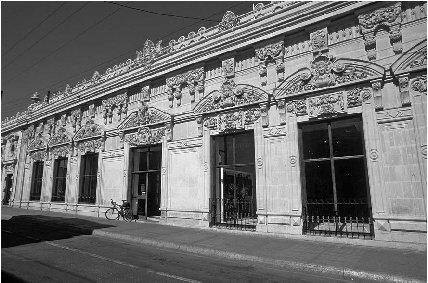
The Mexican Revolution Museum in the capital, Chihuahua, commemorates the history of the 20-year campaign for independence (1910–30).
Anthropologist Carlos Castaneda (1931–1998) was born in Brazil and was widely known for his studies of mysticism among the Yaqui Amerindians. Well-known Mexican composers include Manuel Mar í a Ponce (1886–1948) and Carlos Antonnio de Padua Chávez (1899–1978). Significant figures in the motion picture industry are the comedian Cantinflas (Mario Moreno, 1911–1993), Mexican-born actor Anthony Rudolph Oaxaca Quinn (1916–2001), and director Emilio Fernández (1904–1986).
Notable Mexican sports figures include Fernando Valenzuela , a pitcher for the Los Angeles Dodgers who won the Cy Young Award, for best pitcher in major league baseball, as a rookie. Hugo Sánchez Márquez is a well-known soccer player.
27 Bibliography
Books
Chapman, Gillian. The Aztecs. New York: Beech Tree Books, 2000.
Gray, Shirley W. Mexico. Minneapolis: Compass Point Books, 2001.
Green, Jen. Mexico. Austin, TX: Raintree Steck-Vaughn, 2000.
Gritzner, Charles F. Mexico. Philadelphia: Chelsea House Publishers, 2003.
Marx, David F. Mexico. New York: Children's Press, 2000.
Meister, Cari. Mexico. Minneapolis, MN: Abdo and Daughters, 2000.
Meyer, Michael C., and William Beezley, eds. The Oxford History of Mexico. New York: Oxford University Press, 2000.
Park, Ted. Mexico. Austin, TX: Steadwell Books, 2000.
Reilly, Mary-Jo. Mexico. New York: Benchmark Books, 2002.
Web Sites
Mexico for Kids. http://www.elbalero.gob.mx/index_kids.html (accessed on June 15, 2004).
Visit Mexico. http://www.visitmexico.com/ (accessed June 17, 2004).